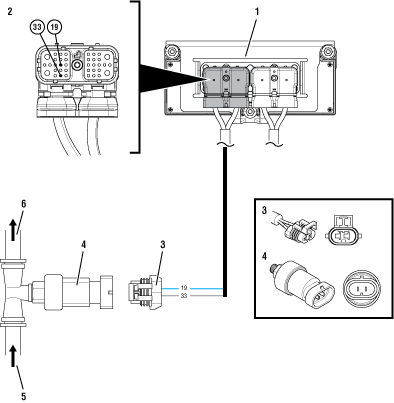Fault Code 21: Auto-Neutral Park Brake Switch
J1587: MID 130 PID 70 FMI 14
J1939: SA 3 SPN 70 FMI 14
Overview
The UltraShift PLUS transmission is equipped with an auto-neutral function. This function shifts the transmission to neutral when the vehicle is brought to a complete stop while the transmission is in gear and the park brake is set. Fault Code 21 indicates a problem with the Auto-Neutral Park Brake Switch circuit.
Detection
The TECU has two options that can be configured depending on component setup. For a TECU configured for a Hard-Wired Park Brake Switch, this fault can be detected anytime the ignition key is on. For a TECU configured for a J1939 Park Brake Switch input, the fault can be detected anytime the J1939 communicates to the TECU from a chassis module (e.g., Cab Controller, Engine, etc).
Conditions to Set Fault Code Active
FMI 14 – Special Instructions: Park Brake Switch is set and one of the following are true:
- Vehicle is moving 11 MPH or greater for more than 9 seconds.
- Hard-wired Park Brake Switch and J1939 Park Brake Switch values do not match for more than 3 seconds.
Note: The fault can also set anytime the Park Brake Switch status remains released for five consecutive power-up and power-down cycles.
Fallback
FMI 14
- Remote Throttle and Split Shaft PTO (if equipped) may be inoperative if the TECU cannot determine if the park brake is set.
Conditions to Set Fault Code Inactive
FMI 14: Park Brake Switch circuit operates normally for 6 seconds or after a power cycle.
Possible Causes
FMI 14
- Park Brake Switch
- Normally open park brake switch installed on chassis (Normally closed is required)
- Internal failure
- Park Brake Switch Configuration
- Incorrect configuration setting
- Vehicle Harness
- Wiring shorted to ground, shorted to power or open
- Bent, spread, corroded or loose terminals
- J1939 Data Link
- Wiring shorted to ground, shorted to power or open
- Bent, spread, corroded or loose terminals
- Operator Influence
- Not setting Park Brake Switch
Component Identification
 |
1. Transmission Electronic Control Unit (TECU) 2. 38-Way Vehicle Harness Connector 3. 2-Way Park Brake Switch Connector 4. 2-Way Park Brake Switch 5. Air Supply 3. To Park Brake System |
 |
Fault Code 21 Troubleshooting
Record the transmission fault codes, FMIs, occurrences, and timestamps from the Service Activity Report created during the Diagnostic Procedure.
Inspect the vehicle to determine if the Park Brake Switch is physically hard-wired to the TECU or broadcast over the J1939 Data Link.
Note: If Fault Code 21 is Inactive and there are other Active fault codes, troubleshoot all other Active fault codes first.
If the Park Brake Switch is directly hard-wired to the TECU, Go to Step B
If the Park Brake Switch is broadcast over the J1939 Data Link, Go to Step D
Key on with engine off.
Connect ServiceRanger.
In ServiceRanger, go to Configuration.
Record current value of the Hard-Wired Park Brake Switch.
Note: Reference the ServiceRanger User Guide (TCMT0072) for more information about the use of ServiceRanger.
If the current value is “Installed”, Go to Step C
If the current value is “Not Installed”, change value to “Installed”. Go to Step V
Key off.
Disconnect 2-Way Park Brake Switch Connector at the Park Brake Switch.
Inspect 38-Way Connector body for damage and bent, spread, corroded or loose terminals.
Key on with engine off.
Measure voltage across 2-Way Vehicle Harness Connector Pin C and Pin D. Record reading(s) in table.

Compare reading(s) in table.
If readings are in range, refer to OEM guidelines for repair or replacement of Park Brake Wiring and Switch. Go to Step V
If readings are out of range, refer to OEM guidelines for repair or replacement of Vehicle Harness between TECU and Park Brake Switch. Go to Step V
| Pins | Range | Reading(s) |
|---|---|---|
| C to D | 4.0–5.0 V |
Key on with engine off.
Connect ServiceRanger.
In ServiceRanger, go to Configuration.
Record current value of the Hard-Wired Park Brake Switch.
Note: Reference the ServiceRanger User Guide (TCMT0072) for more information about the use of ServiceRanger.
If the current value is “Not Installed,” refer to OEM guidelines for diagnosing the J1939 Park Brake Switch.
If the current value is “Installed,” change the value to “Not Installed.” Go to Step V
Key off.
Reconnect all connectors and verify that all components are properly installed.
Key on with engine off.
Clear fault codes using ServiceRanger.
Operate vehicle and attempt to reset the code or duplicate the previous complaint.
Check for fault codes using ServiceRanger.
If no fault codes set Active and vehicle operates properly, test complete.
If Fault Code 21 sets Active during the test drive, Go to Step A
If a fault code other than 21 sets Active during the test, troubleshoot per Fault Code Isolation Procedure Index.